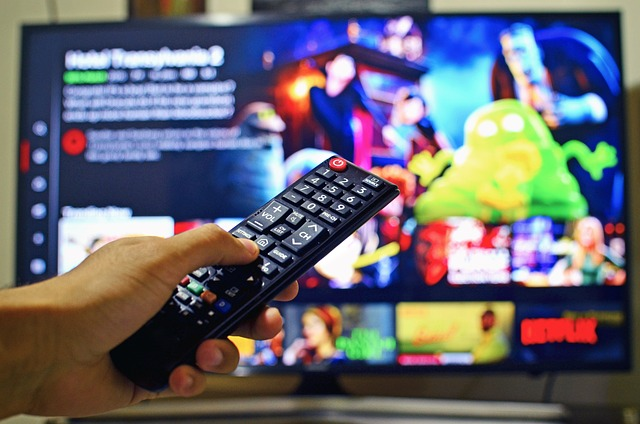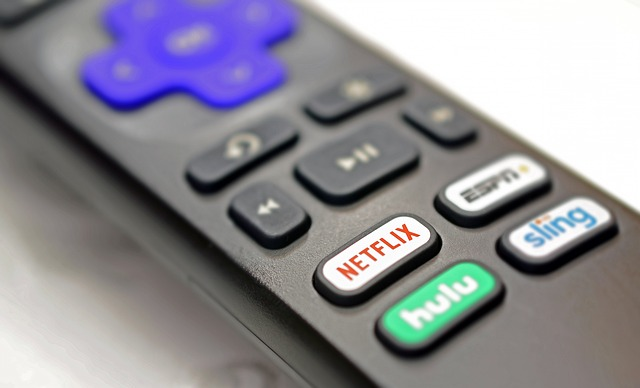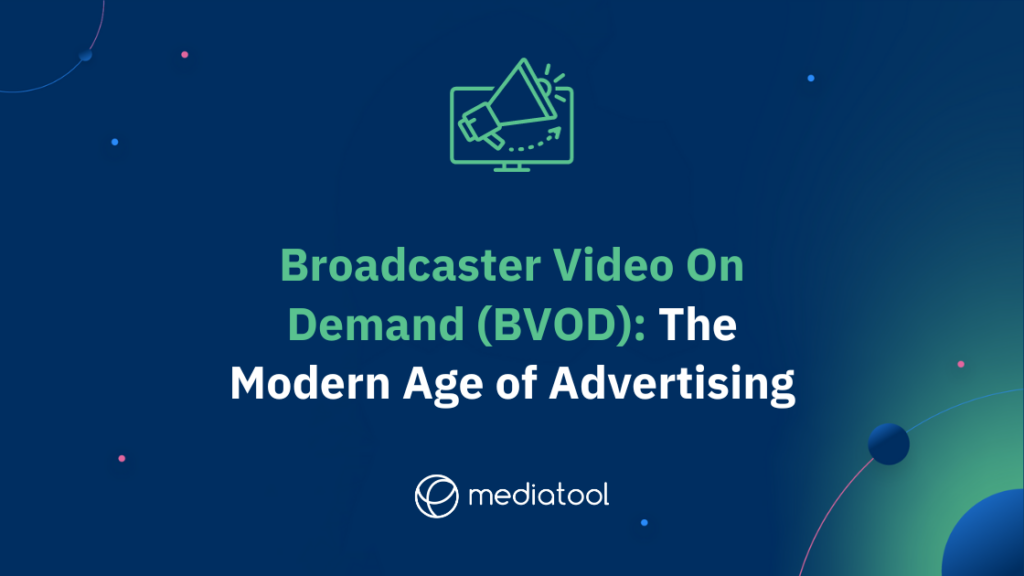What is BVOD Exactly?
Broadcaster Video On Demand (BVOD) represents the digital offspring of traditional TV broadcasters and modern video-on-demand services. Unlike traditional TV advertising, BVOD allows viewers access to high-quality content on platforms that deliver TV-level content without the linear restrictions of scheduled broadcasting.
This evolution in the media industry has been a boon for advertisers. The BVOD model facilitates more dynamic advertising video placements, thus reaching audience segments more effectively. Another significant aspect where the BVOD platform stands out is in offering a personalized user experience. Unlike linear TV, which broadcasts content on a fixed schedule, BVOD empowers its viewers to decide what they watch and when.

Key BVOD Providers
Today, several BVOD platforms dominate the media industry. Respected broadcasters and other BVOD platforms like YouTube, Facebook Watch, and Amazon Prime Video have ventured into this lucrative advertising base, providing viewers with high-quality content and catch-up services.
Beyond these well-known entities, many new BVOD platforms are emerging, keen on capitalizing on this rapidly growing video content sector. Traditional broadcasters, recognizing the demand for on-demand content, are investing heavily in BVOD to ensure they remain relevant in this digital age. These platforms are now becoming integral to consumers’ daily media consumption, often preferred over traditional TV.
Increased Targeting Capabilities
BVOD advertising strategy transcends the broad strokes of traditional television advertising. It offers razor-sharp targeting, enabling brands to specifically target ads based on detailed audience segments, ensuring a more personalized viewer experience. The burgeoning popularity of BVOD is a testament to its effectiveness and alignment with current viewer preferences.
In fact, the Video-on-Demand market worldwide, which includes platforms like BVOD, is projected to reach a revenue of US$159.90 billion by 2023.
Targeted advertising on BVOD platforms offers a level of precision previously unattainable through traditional TV. Brands can optimize their campaigns based on real-time viewer data, leading to higher engagement rates and improved ROI. Furthermore, with tools and analytics integrated into BVOD services, advertisers can better understand their target audience’s preferences, watching habits, and more.
Research has shown a striking level of engagement with BVOD ads, revealing that an impressive 85.9% of viewers actively pay attention during these advertisements. In comparison, YouTube ads hold the attention of 71% of viewers, while social media ads engage just 50% of their audience. This demonstrates the superior ability of BVOD to capture and maintain viewer attention, making it a highly effective platform for advertisers.
The Benefits of BVOD Advertising

- Razor-sharp targeting: BVOD allows for pinpoint accuracy in ad targeting. Combining BVOD campaigns with data analytics will enable brands to reach their target audience more effectively than other digital channels.
- Increased reach: BVOD platforms expand the horizons of traditional TV. Platforms like YouTube or other BVOD services grant advertisers a very lucrative advertising base, extending reach beyond the typical TV audience to some of the most effective advertising platforms.
- Guaranteed brand safety: Respected broadcasters ensure no inappropriate or offensive content tarnishes a brand’s image. This ensures that ads displayed maintain brand safety, eliminating concerns associated with offensive content.
Another benefit of BVOD advertising is its resistance to ad fraud, a prevalent concern in the digital advertising space. BVOD platforms, governed by respected broadcasters, ensure a more controlled environment, minimizing the risks of ad fraud. Furthermore, the BVOD advertising strategy offers an immersive viewing experience. The video quality and relevant ads ensure that viewers are more engaged, leading to better ad recall and effectiveness.
Traditional TV Broadcasters are Moving Online
Traditional TV broadcasters have recognized the shift in viewership patterns. As consumers flock to digital channels for on-demand content, traditional broadcasters adapt and launch their BVOD services to retain and attract ad viewers.
The digital migration of traditional TV broadcasters is a response to the changing landscape of the media industry. They understand that the audience’s consumption habits have evolved, making digital platforms more appealing due to their convenience and variety.
To compete with other BVOD platforms, many broadcasters have ensured high-quality content is available on their services. The integration of features previously only available on platforms like YouTube or other social video services is also seen in broadcaster video on demand services.
Trackable Advertising Campaigns
One of the most significant advantages of BVOD over traditional TV advertising is the trackability of campaigns. Advertisers can now measure performance in real-time, understanding which campaigns resonate best and which require tweaking.
Unlike traditional TV advertising, where metrics can be ambiguous, BVOD advertising allows for a more granular view of audience segments, enabling advertisers to optimize their campaigns efficiently.
The data collected from BVOD and social video platforms provides a detailed insight into viewers’ behaviors, preferences, and ad interactions. Combining BVOD campaigns with sophisticated data analytics tools can guide advertisers in making informed decisions about their strategies.
BVOD Audiences and Viewing
The audience for BVOD is diverse. Many prefer BVOD platforms for their high-quality content, while others enjoy the flexibility to catch up at their convenience. This means BVOD ads can tap into a broader demographic, making BVOD advertising highly effective.
In a notable shift, broadcaster video-on-demand is anticipated to surpass subscription-based video streaming services in viewership within the UK for the first time, according to a forecast from February 2023.
BVOD platforms cater to traditional TV enthusiasts and the newer generation that has grown accustomed to on-demand content and social media websites. As linear TV continues to face challenges, BVOD services like YouTube and Amazon Prime Video are growing in popularity. These platforms offer a mix of original series, shows from traditional broadcasters, and user-generated content, catering to various interests and preferences.
For the general population, BVOD constitutes 11% of all television consumption. However, when looking at younger demographics, specifically individuals aged 16 to 34, this number jumps to 28%, highlighting BVOD’s substantial share of TV viewing time among younger audiences.
BVOD vs SVOD — What’s Better?

While BVOD offers on-demand content supported by advertising, SVOD (Subscription Video On Demand), like Amazon Prime and Google Play Movies, requires a subscription fee. While SVOD provides an ad-free experience, BVOD offers a more extensive potential viewer base due to its free access.
A whopping 85% of households in the United States are subscribed to at least one video subscription service, indicating the widespread adoption of these platforms. However, the choice between BVOD and SVOD largely depends on the viewers’ preferences.
Some people are willing to pay a subscription fee to avoid ads and get exclusive content, while others are more flexible and are okay with watching ads if the content is free. Advertisers often lean towards BVOD because of its lucrative advertising base, ensuring a larger audience views their ads.
BVOD, SVOD, TVOD, and AVOD: What is the Difference?
- SVOD (Subscription Video On Demand): Platforms where users pay a subscription fee for access, e.g., Amazon Prime Video.
- TVOD (Transactional Video On Demand): Viewers pay for individual pieces of content, often seen on platforms like Google Play Movies.
- AVOD (Ad-Supported Video On Demand): Free-to-access platforms like YouTube, where revenue is generated from ads displayed to viewers.
These models each have their benefits and challenges.
While SVOD services tend to have a loyal user base willing to pay for premium content, AVOD services have a broader reach as they are freely accessible.
TVOD, on the other hand, is transaction-based, which means it can generate higher revenues for specific popular content but may struggle with consistent user engagement.
BVOD and AVOD platforms are attractive for advertisers because they offer a broad and engaged viewer base, making targeted advertising strategies more effective.
Key Takeaways
- BVOD represents a bridge between traditional TV and modern on-demand services.
- The ability to specifically target ads and track campaign effectiveness makes BVOD advertising highly advantageous.
- Traditional broadcasters are adopting BVOD platforms to stay relevant in the digital age.
- The difference between BVOD, SVOD, TVOD, and AVOD primarily lies in their monetization models.
With the growth of digital platforms, BVOD stands as a testament to the evolution of broadcast video in the internet era. Offering viewers access to high-quality content without the restrictions of traditional TV schedules, BVOD platforms are rapidly becoming a favorite among consumers.
Respected broadcasters are diving deep into the BVOD space, ensuring they remain pertinent and continue to offer value to their viewers. As for advertisers, the rise of BVOD platforms presents a golden opportunity to reach a vast audience, making their advertising strategies more effective and efficient.
Conclusion
As the digital age reshapes the media industry, BVOD emerges as the pinnacle of this transformation. BVOD, a seamless fusion of traditional TV and modern video on demand services, offers a revolutionary way for audiences to access high-quality content.
Unlike traditional TV advertising, which operates on broad strokes, BVOD advertising provides a laser-focused strategy for targeting specific audience segments. This heightened precision sets BVOD platforms apart, making them one of the most efficient mediums for advertising. Recognizing the immense potential, traditional TV broadcasters are fervently embracing BVOD advertising services.
With platforms like YouTube serving as prime examples, the benefits of BVOD advertising are undeniable. From guaranteed brand safety and minimizing the risk of offensive content to unparalleled targeting capabilities, BVOD stands as a testament to the future of the media industry. To remain relevant, respected broadcasters are shifting to BVOD, prioritizing high-quality content delivery while providing a personalized user experience.
For advertisers, the ability to track campaigns in real-time, combined with a vast and diverse audience base, makes BVOD advertising an unbeatable strategy in today’s digital world.





